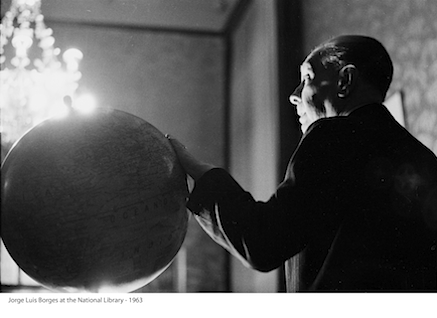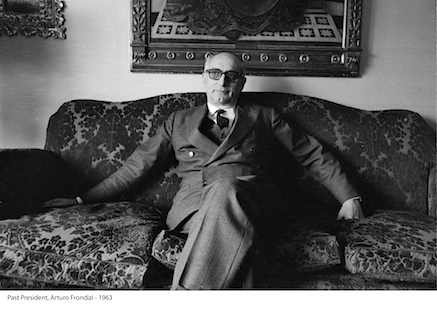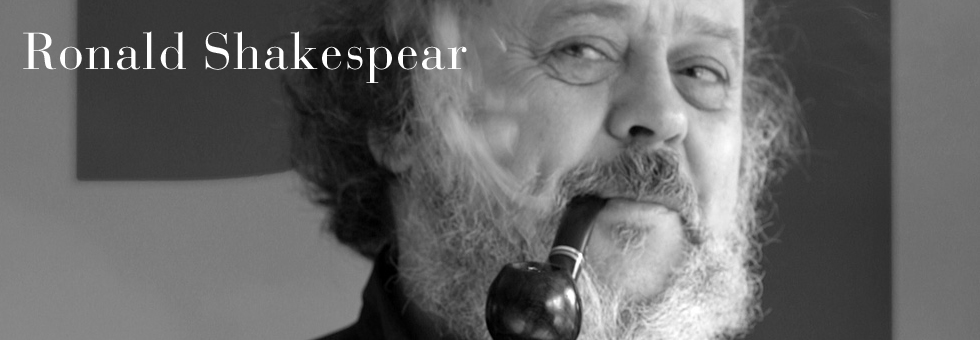http://www.robertlpeters.com/news/allnews/ronald-shakespear-revisiting-the-sixties/
2 November 2012
Ronald Shakespear | Revisiting the Sixties
Buenos Aires, Argentina
This week, a lovely little cloth-bound book of photographs arrived at my studio, Revisiting the Sixties by my long-time friend Ronald Shakespear. You can see more of his eclectic collection of images in an exhibit (PDF) here, or flip through the book online (via issuu) here.

One day in 1964, I took a plane to Spain to go see Orson Welles, who lived near Juan Perón in Puerta de Hierro. I knocked on his door, without an appointment, and was surprised that he opened the door to me — it did not matter that I had arrived “just like that.” There he was, the great Orson, washing down an old Buick (which never actually ran). The fact that I had no appointment mattered not at all: “Never ask permission,” he said, “Never.”
That cemented my admiration for him. He invited me to the Plaza de Toros in Madrid, I spent a lovely afternoon and took some pictures that I still love. We spent an unforgettable afternoon watching the master bullfighter Curro Giron… then we went to the Plaza Butchery (to buy meat) and Giron gave the bull’s ears to Orson.»

Ronald Shakespear has accomplished what only a few chosen ones do: a total work of art, his own life. As he would say, let us draw a compassionate veil on the long years of our friendship… and throughout those long years, I do not remember him ever stopping to rest, ever taking a break from his multi-faceted creative endeavors that have brought beauty to all things around us, by adding colour to the existing grey. And that includes his photographic work, one of his many talents, where black and white give his touching images the importance of being a precious document of his world and ours.
—Edouard Golbin, Photographer (Paris)

Ronald’s photographs are, first and foremost, photographs. They are pictures of light falling unto things and somehow discovering (and covering) them: direct, strong, bold, more shadow than light. The subjects come later… They are all a self-portrait, a portrait of intensity as a photographic theme. Once again, it’s all Ronald: that is how he talks. That is his language. Those are his signs. Frontal, straightforward, no beating about the bush. Why should his photographs be any different?
—Jorge Frascara, Icograda Past President (Padova, Italy)

Narrative talent is a constant in the work of Ronald Shakespear… “Revisiting the Sixties” is flooded with a poetic yet earthly presence that can be seen in every single portrait. Ronald’s eye is a lens that encompasses all the senses and enables us to share into that intimate, personal world, not only through our eyes, but also through that which is beyond our eyes.
—Marcelo Ghio, Dean, Isil University (Lima, Perú)

Today, we know Ronald Shakespear as a designer with a wide portfolio of celebrated identity and environmental graphics projects. But in the 1960s, one of his primary modes of visual expression was portraiture, harnessing black and white photography to capture friends and celebrities in intimate moments. In his book “Revisiting the Sixties” he shares these photographs again — and today, with the benefit of time and the breadth of his design career, we can appreciate the threads that tie these photos to the rest of Shakespear’s body of work. Like his most successful logos, these portraits are simple gestures and yet they are iconic in their ability to communicate a great deal within a modest format.
—Leslie Wolke, Writer (Austin, Texas)
Sobre Robert Peters:

Robert L. Peters, FGDC
Robert is a graphic designer and the founding principal of the award-winning design consultancy Circle, based in Winnipeg, Canada. He is a former president of the International Council of Graphic Design Associations (Icograda, 2001-2003), a foreign feature correspondent for Communication Arts magazine, author of the book Worldwide Identity (published by Rockport), a Fellow of the Society of Graphic Designers of Canada (GDC), and an Honorary Member of the Brno Biennale Association. In 2006 he was the recipient of the Koopman Distinguished Chair in the Visual Arts from the Hartford School of Art, University of Hartford, and also served as Designer in Residence in the Faculty of Art & Design, Monash University in Melbourne, Australia. In 2010, Robert was named an INDIGO Ambassador (International Indigenous Design Network).
Robert is active internationally as a consultant and design strategist, policy advisor, writer, juror, and guest lecturer. He was raised and schooled in Germany, Switzerland, and England, and has traveled extensively (nearly 60 countries).
For nearly 30 years Robert has lived in a low-energy passive solar house that he designed and built in the woods of eastern Manitoba. When not immersed in design, he enjoys nature, rock climbing, mountaineering, and human-powered outdoor activities.
